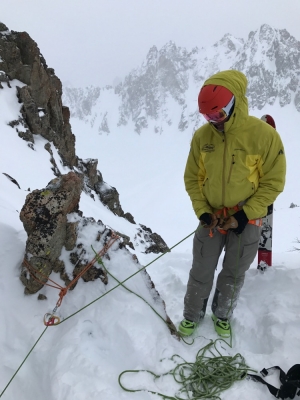
Belaying a skier into the Sickle Couloir in the Sawtooths.
Ski mountaineering season is upon us, and with the epic winter we’ve had, lines are filled in and the spring ski season is likely to be a long one! Several years ago, we wrote a very popular blog post on ski mountaineering equipment. Since then, many advances in gear have made the sport safer and more fun than ever.
Folks registering for our spring Ski Mountaineering Camps at the Williams Peak Hut always ask what gear they need. After all, ski mountaineering is a gear intensive activity. Here are some of our current favorites.
Skis
While here at SMG we’re obviously avid climbers and mountaineers, when there’s snow in the mountains, we tend to keep the “Ski” in “Ski Mountaineering.” As such, most of our guides eschew ultralight rando-race skinny sticks for something with a bit more balanced ski performance. Modern skis construction and materials have come a long ways, and now several manufacturers are making very lightweight touring skis that still perform well. As such it’s difficult to make a definitive recommendation, but three of our guides are skiing on the Black Diamond Helio 105. At 105mm underfoot and a bit over 6.5 pounds, it’s a lot of high performance ski for the weight. It has a rockered tip but otherwise fairly traditional construction. Made by the Blizzard factory in Austria, it definitely has a better feel than BD skis of yore. Other guides at SMG are enjoying K2 and DPS skis.
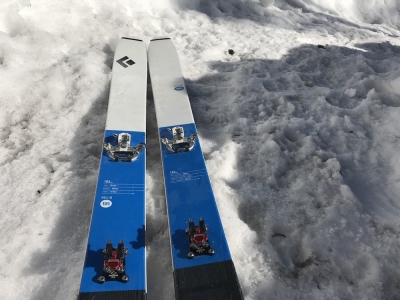
BD Helio 105 ski with Dynafit toe and Plum race heel. Light!
Here are a few other recommendations:
- Width: 95-105mm is a great middle ground. Go narrower and you’ll sacrifice performance in softer or challenging snow, go wider and firm snow (especially skinning) becomes difficult and the weight increases.
- Design: Conservative is good. A bit of tip rocker is nice, but too much rocker or a heavily rockered tail makes for a short running surface. This means less of a platform – if you don’t land your jump turns perfectly balanced, you might find yourself riding a wheelie!
Bindings
If you’re not on a “tech” (i.e. Dynafit-style) binding, you should be. There are many new options out there, and even the burliest of them are much lighter and more efficient than heavy “frame” touring bindings. As many tech bindings become heavier and burlier, a few of of our guides have been experimenting with the lighter, semi-race style bindings such as the Dynafit TLT Superlight 2.0. One of our guides (not a lightweight) has skied over a season on a Dynafit toe/Plum race heel combo with great results. These lighter bindings aren’t for everyone, but you can save a lot of weight while sacrificing very little performance.
Boots
All of our guides are still hooked on 2 buckle touring boots that put weight and touring motion as top priorities. These include the Dynafit TLT6, Atomic Backland, and Scarpa F1 Evo. Once you get used to the hiking boot-like walk mode, there’s no going back. All of these boots ski shockingly well. For those of you not ready to go that minimalist, much of this technology has trickled down into the beefier models as well. As always, the best boot is the one that fits – long days and warm spring temps can be especially hard on feet.
Helmets
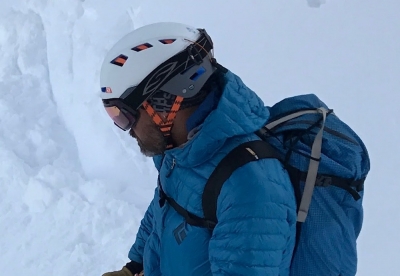
Salomon MTN Lab Helmet – light, ventilated, protective
The old debate of whether to use a light and ventilated climbing helmet with meager protection or a heavy and hot ski helmet may finally be coming to a close. There is starting to be a new crop of helmets certified for both skiing and climbing that walk the fine line between weight, ventilation, and protection – our current favorite in this genre is the Salomon MTN Lab. In fact the ISMF (the international body that governs rando races) now requires cross-certified helmets, and this is likely to increase the options available in coming years.
Pointy Stuff
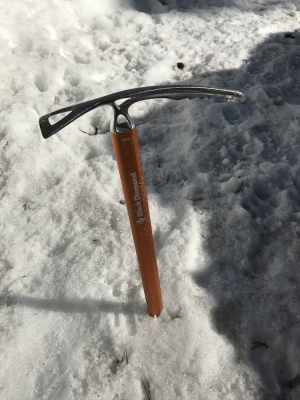
The venerable BD Raven Ultra ice axe – a guide favorite
Not a lot has changed here – for general purpose ski mountaineering, weight is king. Usually we just need a little extra security on steep and/or firm snow.
Ski crampons are critical to efficient spring travel. They’re super useful for skinning on frozen spring snow or hard wind hammered surfaces. Contrary to popular belief, they’re not for going straight up slopes but rather help you keep your edge while traversing or switchbacking firm snow on skins. Most bindings nowadays have specific ski crampons, but Voile sells a universal set that will work on any ski.
Our favorite light axe is the Black Diamond Raven Ultra – it’s superlight yet has a strong steel head. It has a simple, elegant design. Shoot for something in the 12oz weight range, 50-60cm in length, and forget the leash.
Boot crampons are needed less frequently than an ice axe, so they spend a lot of time in your pack. A ton of weight can be saved with aluminum crampons. You sacrifice some durability (you don’t want to walk on rocks with them), but they weigh in at around a pound – about half that of full steel crampons. Check out the new ultralight Petzl Leopard crampon – they only weigh 12 ounces!
Soft Goods
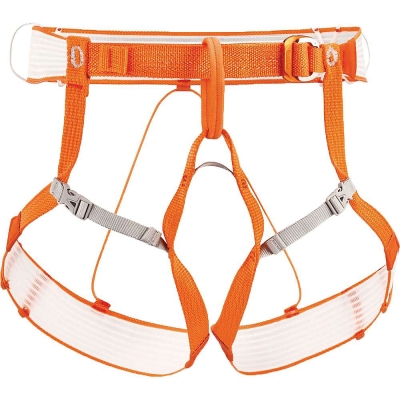
Superlight and packable, the new Petzl Altitude is a top pick
More technical ski objectives can require a rope, harness, and other specialized mountaineering equipment to perform belays and rappels. Do your homework and bring only what you’ll need. Ski mountaineering doesn’t generate the same forces that regular climbing does, so we can get away with carrying a lighter rope. Most ski ropes are 30-40m, 7.5-8mm half ropes.
A harness should be light, packable, and adjustable. There are plenty of light ski harnesses out there, but our current favorite is the Petzl Altitude – ultralight, very thin under your pack, and surprisingly comfortable.
What About Snowboards?
As most (but not all!) of our guides are skiers, we don’t proclaim to be experts on snowboard mountaineering gear. A splitboard rig goes without saying, but we can tell you that folks that have switched to a hard boot set up do much better in challenging spring conditions than those on a traditional soft boot. The hard boot set up is not only lighter, but it does exponentially better in firm skinning and booting conditions. Boot crampon compatibility is much better as well. Many of the ultralight crop of ski touring boots are being modified for use in a hard boot split set up.
Well, there you have it. You got us going on gear and it was hard to stop. Now go out and spend some of that hard earned money on gear, and we’ll see you in the Sawtooths this spring!
